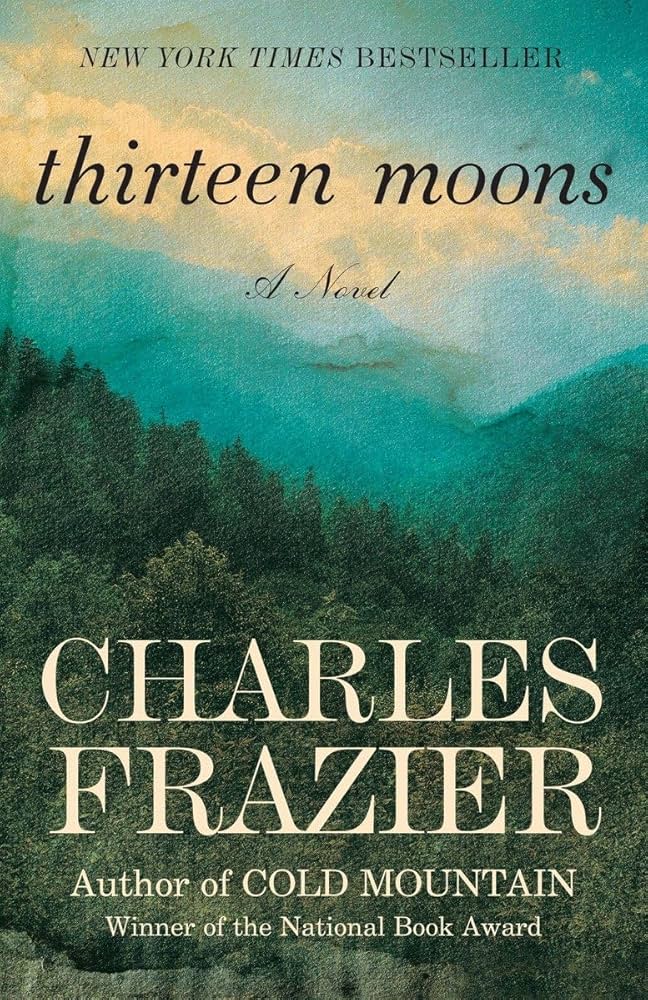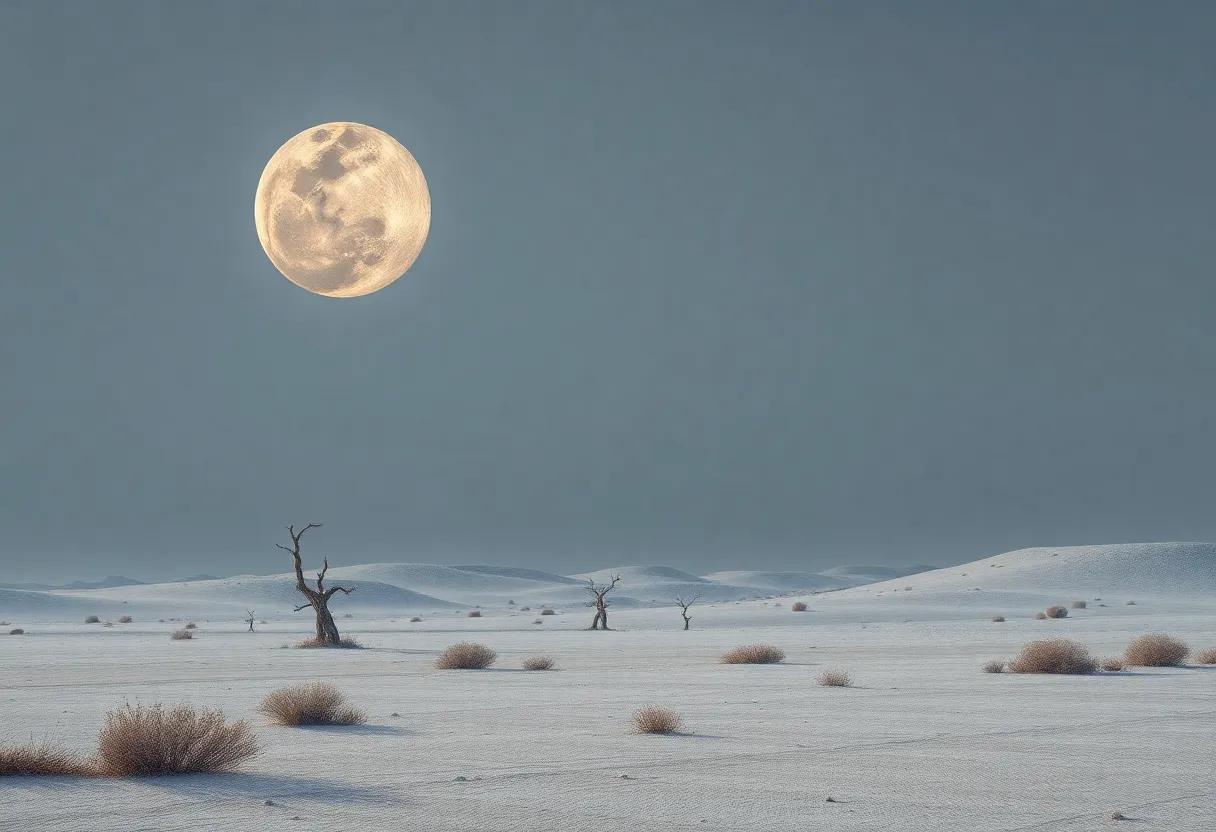In the vast tapestry of American literature, few authors have woven the complexities of landscape and the human experience as skillfully as Charles Frazier. His novel, “Thirteen Moons,” invites readers to traverse the rugged terrains of the 19th-century American South while grappling with the intricacies of identity, loss, and the passage of time. this review delves into the heart of frazier’s narrative,exploring how he paints vivid landscapes that are as much characters in the story as the people who inhabit them. Through lush, evocative prose, frazier connects the natural world with the inner landscapes of his characters, inviting us to ponder the relationship between place and purpose.Join me as we explore the layers of meaning within “Thirteen Moons,” a work that offers not just a story, but a profound meditation on life itself.
The Evocative Power of Landscape in Thirteen Moons
In “Thirteen Moons,” Charles Frazier masterfully intertwines the landscape with the emotional landscape of his protagonist, Will Cooper. The rich depiction of the North Carolina wilderness serves not just as a backdrop but as a haunting presence that shapes the characters and plots alike. Through vivid imagery and metaphorical language, Frazier transports readers into a world where the mountains, rivers, and forests become integral to the identities of those who inhabit them. Each element of nature reflects the protagonist’s journey, echoing his personal struggles and triumphs.
The landscape in Frazier’s narrative showcases not only beauty but also the harsh realities that accompany it. The reader is invited to explore the following themes through the interplay of nature and humanity:
- Isolation: The vastness of the wilderness mirrors Will’s emotional distance.
- Connection: Nature serves as a medium through which Will forms bonds with other characters.
- Change: The seasons symbolize the transitions in Will’s life, reflecting growth and loss.
This dynamic portrayal highlights the delicate balance between man and nature, ultimately suggesting that our surroundings deeply influence our lives and choices, resonating with a broader commentary on existence itself.
Life’s Tapestry: Weaving History and Personal Journey
In Thirteen Moons, Charles Frazier intricately intertwines the broader tapestry of american history with the intimate strands of personal experience. The narrative unfolds against the backdrop of the Appalachian landscape, inviting readers to explore not just the physical world, but also the emotional landscapes of loss, love, and identity. Frazier’s protagonist, Will Cooper, embarks on a journey that mirrors the tumultuous changes in the region, reflecting the impacts of colonization and cultural displacement. throughout the novel, the landscapes are not merely settings; they serve as living entities that shape and are shaped by human emotion.
As the story progresses, the themes of connection and disconnection resonate deeply. The author crafts vivid scenes that highlight the delicacy of relationships—both with the land and among individuals.In Will’s encounters,the following elements emerge:
- Heritage: The exploration of Native American roots and the implications of cultural erasure.
- Isolation: A profound sense of solitude that both character and landscape embody.
- Interpersonal Bonds: Relationships that ebb and flow,reflecting nature’s own cycles.
This carefully woven narrative not only reflects frazier’s lyrical prose but also invites readers to ponder their own journeys in relation to the larger historical and environmental contexts.Through Cooper’s life, we are reminded that history is not just a series of events but a rich tapestry that continues to evolve, shaped by both the threads of the past and the choices of the present.
Character Depth: A Reflection of human Resilience
In Charles Frazier’s “Thirteen Moons,” the characters are a tapestry woven from resilience, reflecting the multifaceted nature of human experience. The protagonist, Will Cooper, embodies the struggle between the relentless pull of past traumas and the hope for reconciliation with both himself and his surroundings. His journey through the unforgiving wilderness of the Appalachian landscape mirrors the harsh realities of life, yet it also illuminates moments of unexpected beauty and connection. Frazier masterfully illustrates how the scars of loss can transform into strength, allowing characters to navigate their turbulent emotions with both fragility and tenacity.
Throughout the narrative, we are introduced to a diverse cast that showcases various responses to adversity, emphasizing the nuanced ways individuals cope with their circumstances.For instance, traditional Cherokee wisdom infuses the story, creating an interplay between cultural heritage and personal history. Key elements that highlight this theme include:
- Interpersonal Relationships: Bonds formed through shared struggles amplify the notion that resilience thrives in community.
- The Natural World: The landscapes serve not just as a backdrop but as active participants in the characters’ paths to healing.
- Chronological Reflections: The nonlinear timeline emphasizes that recovery is not a straight path,but rather an unpredictable journey.
The Role of Nature as a Dynamic Character
In Charles Frazier’s “Thirteen Moons,” nature transcends its traditional role as a mere backdrop, becoming a vital character that evolves alongside the human experiences within the narrative. The landscapes of the Appalachian region, with their dense forests, meandering rivers, and vast mountain ranges, are infused with a sense of agency that reflects the protagonist’s internal struggles. As the seasons shift, so too do the emotions and decisions of Will cooper, illustrating a profound connection between man and the natural world. The author weaves a tapestry of life where the environment influences behaviour, facilitates transformations, and serves as a vessel for both sorrow and solace.
The dynamic quality of nature in the novel is depicted through various elements that showcase its impact on human life. Notably, Frazier employs vivid imagery and sensory details to bring these landscapes to life. Consider the following aspects:
- Seasons: Each season symbolizes different phases in Will’s journey, mirroring his growth and challenges.
- Wildlife: Animals serve as reflections of Will’s emotions, often embodying his solitude or companionship.
- Whether: The changing weather patterns act as a metaphor for the turmoil in Will’s life, leading to moments of introspection.
This nuanced portrayal invites readers to recognize nature not only as a setting but as a living entity intertwined with the fate of its characters. Whether illustrating moments of awe or reflecting tumultuous experiences, the natural world in “Thirteen Moons” stands as a testament to the interconnectedness of existence—a reminder of how deeply human lives are intertwined with the landscapes they inhabit.
Narrative Style: Lyrical Prose That Captivates
In Charles Frazier’s Thirteen Moons, the narrative unfolds like a beautiful tapestry woven from the threads of a bygone era. Frazier’s lyrical prose is a melody that dances across the landscape, painting vivid images of the Appalachian wilderness.Through his rich descriptions, readers can almost feel the cool mountain air and hear the whispers of the trees. Each sentence flows effortlessly into the next, creating a rhythm that mirrors the passage of time and the cycles of nature.The author’s ability to evoke the sensory experiences of the characters allows us to step into their shoes, experiencing their joys and sorrows as if they were our own.
The story is not only about the physical journey of Will Cooper, but also about the emotional landscapes he navigates. Frazier’s skillful use of figurative language enhances the reading experience, inviting us to explore themes of loss, love, and the search for identity. Notably, the use of imagery and metaphor creates layers of meaning that encourage thoughtful reflection. Some key elements that define Frazier’s lyrical style include:
- Evocative imagery: vivid scenes that transport the reader.
- Rhythmic cadence: Flowing sentences that create a musicality to the prose.
- Symbolic depth: Layered meanings that resonate on multiple levels.
Themes of Identity and Belonging Unraveled
At the heart of Frazier’s narrative lies a profound exploration of identity, seamlessly wedded to the ever-shifting backdrop of the Appalachian landscape. The protagonist, Will Cooper, embarks on a journey that not only traverses physical terrains but also delves deep into the realms of self-revelation. Themes of regeneration and loss pervade his experiences, reflecting how one’s sense of self is molded by the land they inhabit. Through Will’s eyes, readers witness the tension between longing for acceptance and the intrinsic solitude embedded within the wilderness. The narrative intricately reveals how connection to place informs one’s identity, as each locale carries whispers of history and belonging, weaving a complex tapestry of existence amidst the unyielding forces of nature.
Frazier deftly juxtaposes internal and external affiliations, inviting readers to ponder the significance of belonging in an ever-changing world. The relationships Will fosters—be it with native tribes, fellow settlers, or even the wild creatures of the landscape—act as mirrors reflecting his evolving sense of belonging. The author deftly highlights this through a few key motifs:
- Connection to Nature: The interplay between Will’s experiences and the landscape reveals how deeply intertwined they are.
- Community vs. Solitude: The struggle between seeking companionship and embracing isolation resonates throughout Will’s journey.
- Cultural Heritage: The rich tapestry of Native American culture woven into the story enhances the theme of identity shaped by ancestry.
Frazier encourages readers to reflect on their own roots and the universal quest for a place to call home, making ‘Thirteen Moons’ not just a story about one man’s life, but a broader commentary on the human experience itself.
Cultural Reflections: Indigenous Voices in Frazier’s Narrative
In “Thirteen Moons,” Charles Frazier weaves a rich tapestry of history and landscape, but it is the voices of Indigenous people that reverberate with profound significance throughout the narrative. The protagonist, Will Cooper, journeys through a land steeped in stories—stories that predate his arrival and ground him within the context of a vibrant culture that is frequently enough overshadowed by colonial narratives. Frazier’s portrayal invites readers to consider the deep, enduring connections between Indigenous peoples and their environments. The fluidity of time within the novel reflects the cyclical nature of Indigenous existence, where the past continues to inform the present and future.
Key themes include:
- Connection to Land: The preservation of traditions and the sacredness of natural spaces.
- Resilience of Culture: The survival of Indigenous languages and practices through generational trauma.
- Voice and Identity: How identity is formed through the interplay of personal and collective histories.
In incorporating Indigenous perspectives, Frazier challenges readers to reflect on their understanding of American history and identity. The rich descriptions of the Appalachian landscape serve as more than mere backdrop; they symbolize a living heritage that is inextricably linked to Indigenous wisdom. By honoring these voices, Frazier enriches the narrative and encourages a greater gratitude of the cultural intricacies that shaped the land long before colonizers set foot upon it. This awareness paves the way for a deeper, more respectful engagement with history and a contemplation of the legacies that continue to influence contemporary life.
Symbolism in Thirteen moons: Nature and Time Intersecting
In Charles Frazier’s Thirteen Moons, the intersection of nature and time emphasizes the profound connection between the protagonist, Will Cooper, and the world around him. nature is not merely a backdrop but an active character that reflects the ebb and flow of human existence. This poignant relationship is portrayed through vivid landscapes that evoke emotions and memories,showing how the changing seasons symbolize the passage of time and the inescapable cycles of life. The novel invites the reader to appreciate the fragility of life, mirrored in the natural world, where moments of beauty coalesce with the inevitability of decay.
Throughout the narrative, Frazier employs symbolic elements that deepen the thematic exploration of existence. Some notable aspects include:
- The Forest: Represents both refuge and encroachment, depicting how nature can offer solace yet also challenge human resilience.
- Water: Serves as a metaphor for change and transformation, signifying how events flow and shape lives.
- The Moon: Acts as a guide throughout the protagonist’s journey, symbolizing the passage of time and the cycles of life and death.
This intricate weaving of nature’s symbolism into the narrative not only enhances the emotional depth of the story but also encourages readers to reflect on their own relationships with time and the natural world. Through Will’s experiences, Frazier emphasizes that understanding life’s temporality is essential for embracing its beauty.
Critique of Historical Narratives Through Fiction
In Charles Frazier’s Thirteen Moons, the intricate tapestry of historical narratives is meticulously woven into the fabric of fiction, inviting readers to question the dominant myths that often overshadow Native American experiences. Through the protagonist, Will Cooper, Frazier artfully illustrates the collision of personal journeys with broader historical events, revealing how individual lives can illuminate the shadows of collective memory. The novel deftly blurs the lines between reality and fiction, challenging preconceived notions about history while concurrently honoring the rich traditions of the Cherokee people. With vivid descriptions of the natural landscape, Frazier constructs a world where the land itself becomes a character, interacting dynamically with Will’s own evolving identity, thus positioning personal experience against the backdrop of a complex and often painful past.
Frazier’s approach to historical contexts encourages readers to grapple with multiple perspectives, particularly through the inclusion of indigenous voices and experiences often overlooked in mainstream narratives. By employing a lyrical storytelling style,he reframes history as a living narrative,which unfolds not just through facts and dates but through the emotional and spiritual connections people have with the land. The novel challenges the reader to consider the weight of history held in personal memory and the shared experiences of loss and resilience. Frazier, through his rich characterizations and immersive setting, offers a critique of historical narratives that frequently marginalize indigenous experiences, urging a re-examination of history that honors the voices of those who have been silenced.
imagery That Transcends Time and Place
In Charles Frazier’s Thirteen Moons, the lush imagery dances off the page, immersing readers in a world that feels both intimately familiar and strikingly foreign. The author’s evocative descriptions of the Appalachian landscape create a vivid tapestry, where the river’s gentle flow and the mountains’ rugged contours are painted with an authenticity that captures the essence of time. through stunning depictions of changing seasons, Frazier transcends temporal boundaries, allowing readers to witness the cyclic nature of life as it unfolds, echoing the rhythms of human existence.
Frazier’s use of imagery evokes a deep sense of place, forming connections far beyond the geographical. By weaving together elements such as:
- Flora and Fauna: Each tree, flower, and creature is imbued with significance, reflecting the harmony and tension between nature and humanity.
- Weather Patterns: The storms and sunrises serve as metaphors for internal struggles and resolutions, enriching the narrative with emotional depth.
- historical echoes: The ghosts of the past linger in the landscape, reminding us of the impact of history on our modern lives.
the author skillfully encapsulates the human experience within the grander narrative of the natural world. As a result,the imagery in Thirteen Moons becomes a portal,bridging the past with the present and allowing readers to resonate with the timeless dance of life itself.
Emotional Resonance: Connecting with Readers’ Souls
In “Thirteen Moons,” Charles Frazier weaves a tapestry of human emotion against the backdrop of the Appalachians. The protagonist, Will Cooper, serves as a medium through which readers experience the profound connection between landscape and life. Frazier’s evocative prose immerses us in the beauty and brutality of nature, illustrating how the land shapes our identities and informs our journeys. With each turn of the page, we encounter the delicate interplay of joy and sorrow, the echoes of love lost, and the bittersweet flavors of existence. This narrative does not simply tell a story; it reaches deep into the soul, urging an introspection that resonates long after the last word is read.
Frazier’s portrayal of characters is steeped in authenticity,making their struggles and triumphs palpable. The reader can find themselves in various facets of these individuals’ lives, as they navigate themes of loss, belonging, and redemption. Moments of intimacy are crafted with such finesse that they encourage reflection on personal experiences, fostering a connection that transcends time and space. Through rich descriptions and emotionally charged dialog, Frazier invites us to explore our own landscapes—the emotional terrains carved by our memories and relationships. This synchronicity creates a reading experience that is not just seen, but also felt, intertwining the personal with the universal in a poignant dance of narrative and emotion.
The Pacing of Life: A Rhythmic Journey Through Nature
In Charles Frazier’s Thirteen moons, the reader embarks on a captivating exploration of the interconnectedness between the human experience and the natural world. Frazier paints a vivid tapestry of life that unfolds in a beautifully rhythmic manner, reflecting the cycles that govern both the landscape and its inhabitants. Through the protagonist, Will Cooper, the author engages us with the changing seasons and their profound influence on personal growth. The landscape becomes a character in its own right, as it shifts and evolves in tandem with human emotions, echoing the ancient belief that nature is a living entity that breathes alongside us. The pacing of life in this narrative is not merely a backdrop but a journey woven together with natural rhythms, captivating the reader’s imagination.
as the narrative flows,Frazier deftly captures the passage of time through moments of stillness and action. Key experiences that highlight this pacing include:
- The Changing Seasons: Each season reflects a new phase of life, from the awakening of spring to the dormancy of winter, illustrating a continuum of renewal and decay.
- Nature’s Sounds: The whispers of the wind, the rustle of leaves, and the call of wildlife punctuate Cooper’s journey, grounding the reader in a sensory experience.
- Personal Milestones: As Cooper navigates loss,love,and longing,his experiences are mirrored by nature’s undulating rhythms,creating a profound connection between the two.
This rhythmic journey through the landscape serves as a poignant reminder that life is intertwined with nature in a delicate dance, where both are shaped by time and experience. Frazier’s portrayal of the land invites readers to appreciate the serene yet powerful cadence of existence, compelling us to listen to the lessons of the world around us.
A Fitting Contribution to American Literature
in “thirteen Moons,” Charles Frazier masterfully intertwines the rugged beauty of the Appalachian landscape with the intricate tapestry of human experience. His lyrical prose not only paints vivid images of the changing seasons but also immerses readers in the historical and cultural landscapes of the region. Frazier’s characters grapple with profound themes of loss, identity, and the passage of time, evoking a deep emotional resonance that underscores the significance of place in shaping personal narratives. The interplay between the vibrant natural world and the struggles of the protagonist amplifies the exploration of American identity, making it a fitting contribution to the canon of American literature.
The novel’s structure, echoing the cycles of the moon, serves as a powerful metaphor for the recurring themes of renewal and transformation in both nature and human life. Readers are invited to embark on a journey that transcends mere storytelling; they are encouraged to reflect on their connection to the land and the history that it carries. Frazier’s deft handling of language and form lends itself to an engaging reading experience that resonates on multiple levels.Through the landscapes he vividly illustrates and the lives he intricately crafts, the novel stands as a testament to the enduring legacy of the American spirit, rooted deeply in the land that nurtures it.
About Charles Frazier: The Mind Behind Thirteen Moons
Charles Frazier is an acclaimed author whose literary voice resonates deeply within the American contemporary fiction landscape. Born in North Carolina, he developed an intrinsic connection with the Appalachian region, which profoundly influences his storytelling. As a writer, he is known for his meticulous attention to the natural world and how it shapes human experiences. His previous work,Cold Mountain,gained immense acclaim,winning the National Book Award and being adapted into a successful film. With Thirteen Moons, Frazier continues to explore themes of loss, love, and the intrinsic bond between humanity and nature.
The narrative journey of Thirteen Moons is as much about the sweeping landscapes as it is about the characters that inhabit them. Set in the historical context of the 19th century,the novel follows the life of Will Cooper,whose experiences reflect the tumultuous transformation of the American frontier. Through vivid descriptions and lyrical prose, Frazier invites readers to connect with the land on a deeper level. His ability to interweave historic events with personal stories showcases his skill in capturing the essence of place and the complexity of human emotion. Frazier’s work is marked by his unique storytelling viewpoint, emphasized by:
- Deep Historical Context: Grounded in real events.
- Rich Sensory Detail: Creating immersive landscapes.
- Complex Characters: Embodying the struggles of their time.
To Conclude
As we draw our exploration of Charles Frazier’s “Thirteen Moons” to a close, it becomes evident that the novel is more than just a narrative; it is indeed a poignant odyssey that intertwines the landscapes of appalachia with the intricate tapestry of human emotion and experience. Frazier masterfully invites us to wander through time, bridging the gap between the past and the present, and urging us to reflect on our own connections to the land and its history.
In this journey,we encounter not only the beauty and brutality of nature but also the profound impacts that love,loss,and resilience have on the human spirit. Through his richly drawn characters and evocative prose, Frazier achieves a delicate balance between storytelling and meditation, urging readers to find significance in the minutiae of life.
Like the cycles of the moon that punctuate the story, “Thirteen Moons” reminds us of the constants in life—change, growth, and the inevitable passage of time. It encourages us to pause and look deeper into our own landscapes, nurturing an understanding that, much like the protagonist, we are all shaped by the places we inhabit and the lives we touch.
As we set the book down, we are left with echoes of its themes resonating in our own lives—an enduring reminder of the connection between our stories and the land we share. In this sense, Frazier’s work transcends mere fiction, becoming a reflection of our collective humanity, urging us to explore not just the landscapes around us, but also the landscapes within.So, we part ways with “Thirteen Moons,” not just as readers, but as fellow wanderers, carrying forward the echoes of its journey.















